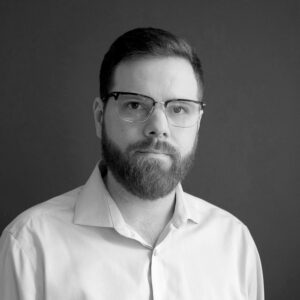How Columbine Went Viral
By Mark Keierleber | April 18, 2019
Twenty years ago, two teenage gunmen killed 13 people at their suburban Colorado high school before taking their own lives. It became one of the largest news stories of the 1990s. Now, researchers are calling on media outlets to rethink coverage of mass shootings to prevent future tragedies. Will it work?
Jefferson County, Colorado
Anne Trujillo was visiting her sick father at the hospital when breaking news flashed across the television screen: Shots fired at Columbine High School.
Victims soon arrived with gunshot wounds, and parents quickly followed, uncertain whether their children were alive or dead. Police responded, too, on the lookout for potential gunmen.
As a news anchor at Denver’s ABC affiliate, KMGH-TV, Trujillo stayed at the hospital to report on the commotion as this suburban community south of Denver came under international scrutiny.
“At first you’re going, ‘Gunshots at a school, let’s check it out, let’s see if there’s information,’” said Trujillo, who has worked at KMGH-TV for more than 30 years. “When we learned more and more, that’s when you literally call in everybody, everybody in the newsroom.”
In the 1999 shooting at Columbine, which unfolded 20 years ago this week, two students killed 13 people before taking their own lives. As the scene unfolded at the school in this quiet suburb, the burgeoning 24-hour news cycle allowed people around the globe to watch — live — from their living rooms.
From a helicopter, the KMGH-TV crew filmed police helping a student escape the school from a second-floor window. Outside the school, traumatized students described the shooters to reporters as “disenfranchised kids,” members of a sinister “Trench Coat Mafia.” Some students said the gunmen were bullied and that the shooting was part of a twisted revenge plot. While hiding under a desk on the second floor of the school, a Columbine student conducted a telephone interview with a network as he watched the broadcast on live television.
In the years after the Columbine shooting became one of the top news stories of the decade, scores of subsequent gunmen have cited — even celebrated — the 1999 attack. A growing body of research suggests the intense media coverage of mass shootings may motivate subsequent attacks. The controversial theory, called “the contagion effect,” suggests that mass shootings have a tendency to spread like a contagious disease. For both mass shooters and the researchers who study them, the template for so much of what came later was the attack at Columbine.
Just this week, school districts in the Denver area closed as police searched for a Florida woman who reportedly traveled to Colorado and presented a “credible” but unspecific threat against schools. Officials said the 18-year-old woman, who reportedly purchased a pump-action shotgun and ammunition in Colorado, was “infatuated” with the Columbine attack. On Wednesday, officials found the woman dead with what appeared to be a self-inflicted gunshot wound.
In 1999, as the Columbine tragedy unfolded, “everybody had their pet theory” about what could have motivated two teens to kill their classmates, former Denver Post reporter Mark Obmascik recalled in an interview with The 74. Many of those theories — the idea that pervasive bullying led the gunmen to violence, and their involvement with the Trench Coat Mafia — turned out to be false.
“There were a number of people convinced that it was guns, a number of people were convinced it was absentee parents, some people said violent video games, some people thought it was, in their minds, the removal of religion from public schools,” said Obmascik, who is now an author. A day after the shooting, Obmascik published a front-page story with inflated claims stating that as many as 25 people were killed. “What do you do if you quote the chief law enforcement official in that county but he’s wrong?” he asked. Under intense scrutiny following the tragedy, the sheriff chose not to run for re-election in 2002.
At the time, the Denver Post was engaged in a fierce newspaper battle with the Rocky Mountain News.
“For newspaper reporters locked in a daily newspaper battle, all of a sudden all of the TV networks started parachuting big people in,” he said. “It’s just the story I wouldn’t wish on anyone. There was nothing good that came out of that story.”
In a 1999 survey, the Pew Research Center found that the Columbine tragedy attracted more public interest than any other story that year. In fact, it was the third-largest news event of the decade, trailing only the 1992 Rodney King verdict and the 1996 crash of TWA Flight 800.
For Rick Townsend, whose daughter Lauren was killed in the shooting, some of the intense media coverage was frustrating. It was painful, for example, to see the killers’ photos on the cover of Time. He feared news outlets were giving the gunmen exactly what they wanted: fame. He worried that notoriety would “feed other people to do the same thing,” Townsend said during a recent gathering at the Columbine High School library. “But it just didn’t seem to matter to the media at the time.”
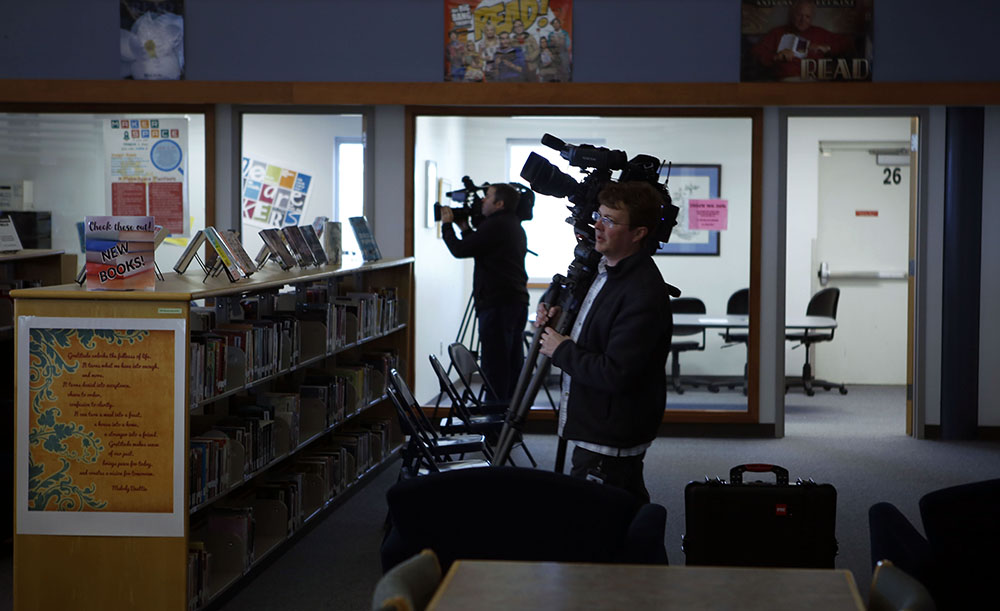
Numerous mass school shootings since Columbine — notably, the tragedies at Sandy Hook Elementary School and Marjory Stoneman Douglas High School — were committed by gunmen who studied, emulated or even fan-worshipped the Columbine assailants.
“I think it’s very safe to say that no one has inspired more copycats than the Columbine perpetrators,” said Adam Lankford, a criminology professor at the University of Alabama. “Not coincidentally, Columbine was one of the most intensely media-covered events of the entire 1990s.”
The copycat
Ten days after the Columbine attack, psychologist Peter Langman of Allentown, Pennsylvania, was assigned to evaluate a 16-year-old boy with a hit list of people he wanted to kill. At the time, Langman worked at a psychiatric hospital for children and adolescents. The 16-year-old wouldn’t be the last teen at the facility to present a risk.
“After him, there was another potential school shooter,” Langman said. “And another one. And another one.”
At the time, little was known about the psychology of school shooters — a topic Langman has spent about two decades trying to understand. His website contains more than 500 documents related to 150 perpetrators of mass shootings, including journal entries, blog posts, classroom assignments and police records. Time and again, he found, perpetrators of mass shootings — in and outside of schools — emulated previous attackers.
“It is fascinating to see how many times people research a previous shooter,” Langman said. Sometimes, mass shooters idolize previous gunmen, quote them, dress like them or feel they share personal connections. “The confusing thing is, what does that mean in terms of influence versus causation? Would these other attackers have happened without Columbine?”
While schools have become safer in recent years and mass shootings on campuses remain statistically rare, according to federal Education Department data, the statistics on active shootings go in the opposite direction. Since Columbine, Federal Bureau of Investigation data indicate, the number of active shootings has spiked. The definition of a “mass shooting” remains hotly debated among researchers. But the FBI defines an “active shooter” as someone who attacks a populated area.
Last year, the FBI released a report on the pre-attack behaviors of active shooters, and although perpetrators don’t share any demographic traits beyond the fact that they’re typically male, they often display multiple warning signs that can be observed by classmates or teachers. Those warning signs include physical aggression, potential symptoms of a mental health disorder, leaking plans and an obsession with violent media. In some cases, people plotting an attack take on a “pseudo-commando identity or a warrior mentality in which the person of concern starts gravitating towards and really identifying with a violent actor,” said Andre Simons, supervisory special agent at the FBI’s behavioral analysis unit.
When someone starts to identify with previous attackers, Simons said, it raises red flags.
“That sense of identification, in many ways, starts to transcend the normal interest that you might find adolescents might have in violent past events, to the point where it starts to supersede or saturate their thinking,” he said. “Their time, their energy all becomes focused on these past active shooters.”
In a case of fatal foreshadowing, one of the Columbine gunmen predicted in a video what would happen next: “I know we’re gonna have followers because we’re so fucking God-like.”
That’s what they got.
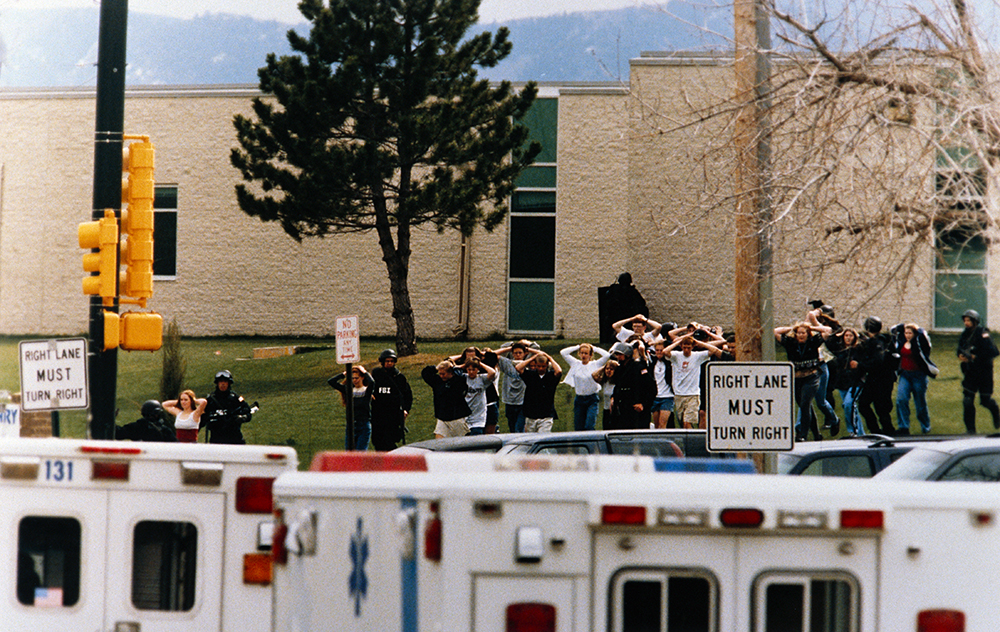
Celebrity cachet
In the internet age, “going viral” has become part of the American lexicon, from “Gangnam Style” to the “Tide Pod Challenge.” In the same sense, some researchers argue, journalists have inadvertently turned gunmen into celebrities.
“It’s like people see Kim Kardashian on TV and they want to dress like her, they want to wear her perfume, they start saying catchphrases that she says on TV,” Lankford said. “To a much narrower extent, we see the same thing with a small subset of people who essentially worship previous mass shooters.”
A key motivator for a majority of mass shooters is “the fame and power they perceive they will achieve for their crimes,” according to one 2016 report.
Evidence suggests the Columbine shooters sought out such notoriety. They even considered mailing their writings to news outlets and discussed which director might make a movie about them.
The gunman who killed 32 people at Virginia Tech in 2007 before taking his own life referred to the Columbine shooters as “martyrs” and claimed his gruesome vendetta “will reverberate throughout every home and every soul in America.” Prior to killing 10 people at Oregon’s Umpqua Community College in 2015 before taking his own life, the gunman referenced a previous attack in a blog post. That previous attack, the Oregon shooter observed, made the gunman famous.
“So many people like him are all alone and unknown, yet when they spill a little blood, the whole world knows who they are,” the Oregon shooter wrote. “His face splashed across every screen, his name across the lips of every person on the planet, all in the course of one day. Seems the more people you kill, the more you’re in the limelight.”
Before the 2018 high school shooting in Parkland, Florida, the alleged gunman filmed a video with a similar observation. “With the power of my AR,” he said, referring to his firearm, “you will all know who I am.”
Since Columbine, a significant body of research has explored the way news outlets report on mass shootings.
One study found that attacks with multiple casualties were more likely to appear in the pages of The New York Times. Newspapers are more likely to feature front-page photos of shooting victims than those of perpetrators, according to one study from last year. On a photos-per-individual basis, however, newspapers gave 16 times as much attention to the perpetrators as those who were murdered. Photos of gunmen also tended to appear larger on the page.
Recognizing that perpetrators of mass violence often seek fame, the FBI is currently conducting research on the topic. Officials are eager to ask gunmen who survived their attacks how they perceived news coverage of their crimes.
“We want to ask them, how much media coverage did they watch after they committed the active shooting? What did they think about the media coverage?” said Sarah Craun, a research coordinator at the FBI. “What did they like? What did they dislike?”
The contagion
When someone famous takes their own life, more suicides often follow in quick succession. After Robin Williams took his own life in 2014, for example, the national suicide rate increased by nearly 10 percent.
Though concerns of suicide contagion have existed for hundreds of years, more recently researchers have concluded that a similar trend exists following mass shootings. Researchers liken the effect of tragedies with multiple victims to the spread of a viral disease. At least 11 studies, dating back to the 1970s, have documented the trend.
In one of the studies, from 2015, researchers at Arizona State University found a heightened probability of violence in the immediate aftermath of a mass shooting. For 13 days after a mass shooting, on average, another shooting with multiple casualties was more likely to transpire. Media coverage of mass shootings, researchers hypothesized, “may promote ideation in vulnerable individuals.” A similar contagion effect didn’t appear to exist following shootings with fewer victims, “possibly indicating that the much higher frequency of such events compared with mass killings and school shootings reduces their relative sensationalism, and thus reduces their contagiousness.”
“In truth, and especially because so many perpetrators kill themselves, we likely may never know on a case-by-case basis who was inspired by similar prior acts, particularly since the ideation may have been subconscious,” according to the report.
Despite a long history of documented copycats and recent reports showing a contagion effect in the immediate aftermath of mass shootings, it’s likely impossible to quantify media influence on attacks, said Jaclyn Schildkraut, a criminal justice professor at the State University of New York at Oswego.
Similarly, it’s impossible to know the precise motives of the Columbine killers, she said, because they died in the school that day.
“Here’s the reality: There’s not one thing to blame,” Schildkraut said. “It’s not only the media. It’s not only the guns. When you look at things like Columbine or other types of events, these are perfect storms of many different factors.”
Adding to the complexity is a 21st century reality: Media is more fragmented than ever. For example, the Columbine attack transpired before the rise of social media; Myspace hadn’t been invented yet. In the modern era, however, platforms like YouTube and Facebook have become outlets for gunmen and those who obsess over violent tragedies to share their perspectives.
During a March rampage killing in Christchurch, New Zealand, which resulted in 50 deaths, the gunman streamed parts of the attack on Facebook. That attack resurfaced concerns over contagion and the role media can play in inspiring subsequent tragedies.
Coni Sanders, whose father taught at Columbine before he was killed in the shooting, has firsthand experience with the gunmens’ online idolizers.
“There are currently over 150 false social media accounts claiming to be the boys that murdered my dad,” Sanders said. People contact her regularly over social media with hopes to learn more about the Columbine attack.
Social media companies, Sanders said, haven’t been vigilant about removing profiles that are clearly fake. Pointing to the New Zealand shooting, she questioned whether social media platforms should offer live video. She proposed a 45-minute delay that would allow the videos to be better scrutinized.
“I can’t even get them to take a damn profile down of somebody who’s claiming to be my dead dad, or the person that murdered him,” Sanders said. “I don’t know how we’re going to convince them to delay a video.”
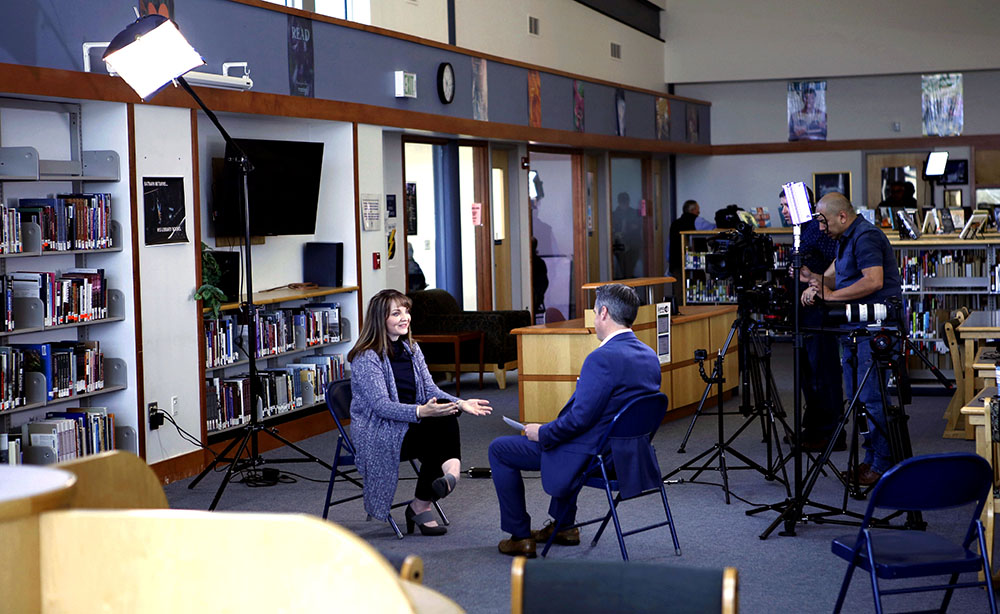
No notoriety
If it’s notoriety some gunmen seek, Lankford said, the solution to prevent some shootings should be simple: Don’t give it to them.
After a gunman killed 12 people at an Aurora, Colorado, movie theater in 2012, the parents of one victim created the No Notoriety Campaign, which urges reporters to withhold the names and photographs of active shooters in most situations. Since then, researchers, psychologists and law enforcement officials have joined in. After the school shooting in Parkland, a White House commission formed to study school violence recommended that news organizations adopt the practice.
And while researchers who’ve studied contagion said that No Notoriety could have a positive effect, they stopped far short of saying it’s a solution to avert all mass killings.
“I’d love to sit here and say, ‘OK, if we got every journalist in the United States of America and in the world to adhere to no notoriety, that we would never have mass shootings again,’” Schildkraut said. “I’d be an idiot if I said that to you. Do I think it would make a difference? Absolutely.”
Some journalists have fallen in line. CNN’s Anderson Cooper, for example, declined to name the perpetrator of the 2012 attack at Sandy Hook Elementary School in Newtown, Connecticut.
“We are not, during this broadcast, using the name of the shooter,” Cooper said on the air. People typically remember “the names of murderers,” he said, “and not the names of victims.”
Not everyone agrees, however. As the March mass shooting in New Zealand prompted new debates over the idea of media contagion, Jack Shafer, Politico’s chief media writer, wrote a scathing critique of the concept, calling the evidence “leaky.” While some mass shootings have inspired copycats, he wrote, plenty of others haven’t.
“The first job of a journalist is to get the news,” Shafer wrote in an email, “not practice ‘harm reduction.’”
Reflecting on her own coverage of Columbine, Trujillo of KMGH-TV said it’s important to report on mass tragedies with compassion. She said it’s unnecessary to publish clips of the New Zealand shooter’s manifesto, for example. She also said it’s important to be more discerning with information provided by police, and to be upfront with viewers about details that are unknown. But she’s skeptical about media contagion, calling it “one of those easy things that people point to.”
“I don’t think it can be that simple,” she said. “Can we learn how to do a better job of reporting shootings? Absolutely. I think we’d be foolish to think that because we’re journalists we have to put everything out there unfiltered.”
Obmascik, the former reporter at The Denver Post, also has qualms with the concept. Reporters, he said, have an obligation to share what they know with the community. “Censorship leads to bad places,” he said, referring to the campaign urging journalists to withhold the names of gunmen. With all facts out in the open, he said, it’s up to policymakers to decide what comes next.
“You can’t make decisions in the future if you don’t know the facts of what’s happened,” he said. “People may have different philosophies, they may have different ideologies, but we can at least agree on a set of facts.”
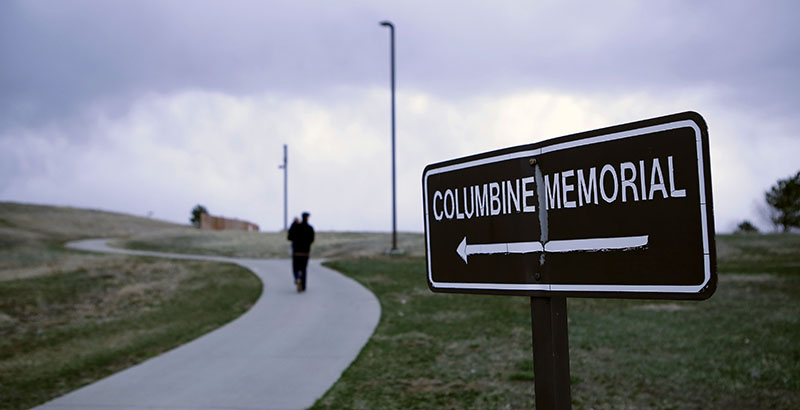
‘A whole different animal’
Twenty years after Columbine, few visual signs of the attack remain in this Denver suburb, characterized by sprawling neighborhoods and strip malls. In Clement Park next to the campus, a nondescript sign guides visitors up a winding path to a memorial carved into the top of a hill.
On a Saturday morning last month, a cadre of journalists descended on Columbine, nearly two decades since the school became the focus of international attention.
Fourteen local and national media outlets, including The 74, were invited to the Columbine High School library to hear from residents who survived or lost loved ones in the tragedy. The families bounced between outlets to share intimate stories of how their lives changed since the attack.
In interviews, they shared memories of their loved ones, their trauma and grief, and ways they hope to inspire a more peaceful world.
They also reflected on how their stories were portrayed in the popular press, when their lives were thrust under a microscope.
“Grieving in the spotlight is a whole different animal,” said Heather Martin, who graduated from Columbine High School a month after the shooting. Today, she’s a high school English teacher in nearby Aurora, Colorado. “Grief is grief and trauma is trauma, but it has a little different spin to it when everybody is watching.”
Some said they were grateful for the media, which reported on anti-violence initiatives that grew out of the tragedy in their community. Others, however, argued that journalists too often glorify gunmen. Journalists have an opportunity, Sanders said, to reduce the seduction of fame.
“I want to be realistic: This is a very complex issue,” and rethinking media coverage of mass shootings won’t stop all attacks, she said. “We have no one solution, but it’s a piece. And if we can solve one little piece at a time, we may be able to make an impact.”
Lead image: Getty Images
Get stories like these delivered straight to your inbox. Sign up for The 74 Newsletter

